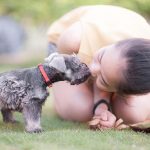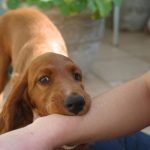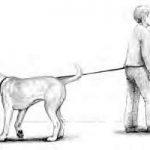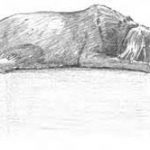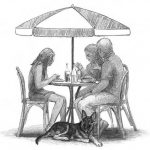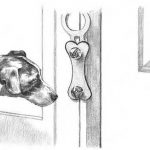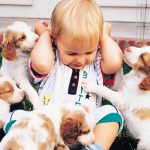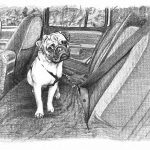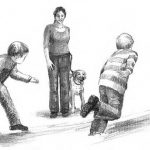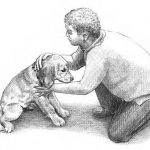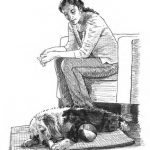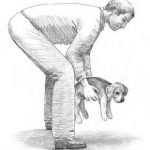In This Chapter
- Making sure your puppy’s basic needs are met
- Communicating by using the language of a pup
- Establishing who’s in charge of the household
- Discovering how to train your puppy from his perspective
- Motivating your puppy appropriately according to his age
In my opinion, the greatest gift you can give your puppy is a stress-free existence. Structure your puppy’s world so that he feels safe. Provide for his needs, anticipating them before he does, and incorporate as much playtime into your daily routine as you can. A young puppy won’t understand the word “no” or develop impulse control before 6 to 8 months, so put your expectations and frustrations on the back burner until you can channel both into useful communication. Puppyhood, like childhood, is short — let your puppy enjoy his to the fullest.
You have to understand the world from his perspective. He’s brand-new to the planet, and curiosity is his guide. Though his curiosity may result in behaviors that you find aggravating, don’t take any of his antics personally: After all, he’s just a baby. Getting angry at a puppy is as silly and ineffective as yelling at a 6-month-old child. Not only will you not get through to him, you’ll also frighten him. You, the very person he should feel most safe turning to, will be scaring and confusing him. This routine is neither educational nor good for long-term bonding. There is a better way to navigate through this time — a much better way.
In this chapter, I show you how to put yourself in your puppy’s paws and understand just how your puppy views your world and life together. Consider learning about your puppy’s worldview an adventure — let the fun begin!
Understanding Your Puppy’s Basic Needs
Your puppy is a lot like a human baby. Okay, sure, your pup may have a curly tail and a full set of teeth, but many of the differences stop there. Like a child, your puppy has basic needs and an instinct to satisfy them. A baby communicates her helpless neediness through crying. It’s a guardian’s role to interpret the cry and satisfy the need. In essence, a cry indicates that the baby lacks the ability to associate a specific need with a bodily sensation. When she’s hungry, her belly hurts. When she’s tired, her brain shuts down. When she’s thirsty, her throat constricts. If these needs aren’t satisfied, she gets anxious. When the needs are routinely satisfied by a loving caregiver, without stress, discipline, or confusion, she’ll develop a strong bond with that person.
The same holds true for puppies. Like babies, they have five basic needs: eat, drink, sleep, potty, and play. Unlike babies, puppies don’t cry when their needs aren’t met. Instead, they start nipping and, if directed, may bark and become frantic and fidgety. The behaviors are different, but the concept is the same. Both are easily overwhelmed when their bodies make demands. If initial nips are met with harsh discipline, the puppy may develop defense reactions, such as aggression or barking back.
Tip
You can help your puppy identify his needs by pairing directions with routines. Whereas a child will develop language and a more civilized approach to communicating her requests, your puppy will develop his own system of communicating by prompting the routine. Read about puppy needs in the upcoming sections, and use Table 6-1 to create your own routines — your puppy will be ringing the bell to go outside in no time!
Remember
Whoever satisfies a need is held in high regard. Though it may take some time for your puppy to “pay you back” with his love and devotion, each passing day brings you closer to that ultimate connection. Need by need, your bond will grow.
Table 6-1 | Needs Chart |
Your Pup’s Need | The Word or Phrase You Say | The Routine You Follow |
Eating | Hungry or eat | Schedule feeding times. Place the bowl in the same spot and encourage your puppy to sit before feeding. |
Drinking | Water | Keep the bowl in the same spot. Encourage him to sit before drinking. |
Going potty | Outside, papers, go potty, or get busy | Encourage your puppy to nose/paw a bell to signal this need. Follow the same route to the same potty spot. Restrict attention until your puppy goes. |
Sleeping | On your mat, in your crate, or time for bed | Designate one spot in each shared room. Take your pup to his mat or bed, provide a chew toy, and secure if necessary. |
Playing | Bone, ball, toy, or go play! | Establish a play area inside and outside the house. Make sure all four paws are on the floor before you toss a toy or give a bone. |
Eating
Puppies are happiest when a predictable routine has been set. A hungry puppy is understandably upset and may show you by eating anything — even the difficult-to-digest things such as tissues or walls! Schedule feeding times and stick to them as closely as possible. If you notice your puppy getting nippy or difficult, check your watch. The behavior could be a result of hunger tension. See Table 6-2 for guidance when setting up feeding times.
Table 6-2 | Your Puppy’s Feeding Schedule |
Age | Morning Meal (7 a.m.) | Midday Meal (11:30 a.m.) | Afternoon Meal (4 p.m.) | Late Evening Meal |
8 to 10 weeks | * | * | * | * |
10 weeks to 4 months | * | * | * | |
4 to 6 months | * | | * | |
A young puppy has a high metabolism and should have more frequent meals. Schedule three to four meals throughout the day, slowly phasing out meals as your puppy matures. At some point after your puppy reaches 4 to 6 months, he’ll naturally drop one meal.
Remember
Whoever feeds your puppy should follow the same organized routine that you do. Puppies (like kids) are happiest when they know exactly what will happen next. For example, in my house, whoever feeds our dog, Whoopsie, says “Kibbles,” lifts her bowl, fills it up, and waits for her to sit before returning it to her eating station.
Drinking
Puppies need a lot of water, especially when the weather is hot or when chewing and playing. Even though it’s important to allow them access to water when their system demands it, it’s equally important to monitor their drinking habits. Bladder muscles are the last to develop, so what goes in, comes out quickly!
Establish a drinking station for your puppy and keep his dish there whether it’s empty or full. Give your puppy water with his meals; after playing, chewing, or napping; or as you’re on your way to his potty area. If you’re forgetful, it’s better to fill his dish and leave it out for him throughout the day. Though it may delay your housetraining, it’s better than having him go thirsty.
Tip
Restrict water after 7:30 p.m., unless you want to be up all night taking your puppy outside. If your puppy clearly needs a drink, either give him a small amount (no more than a cup for a large dog or 1⁄4 cup for a small fry) or offer a couple of ice cubes.
Sleeping
We all love a good sleep, and you’ll find that your puppy is no exception. Create a quiet space where your puppy can escape the daily hubbub and catch up on his z’s whenever he needs too. Make it clear to friends and family that this area — perhaps a crate, bed, room, or pen — is off-limits to people when your puppy needs to nap. An overtired puppy is impossible to deal with. Like a child, a puppy will simply melt down. In fact, when pushed, his mouthy, testy behavior may turn into snappy aggression. Don’t correct, worry, or admonish him. Have pity instead — he’s exhausted.
Tip
Like kids, some puppies have a hard time putting themselves to sleep, especially when excitement levels are high. If you have kids, ask them to baby him by staying quiet until he’s sleeping. Each time he seems tired, escort him to his resting area while saying a cue word like “bed.” Eventually he’ll go to this area on his own when he’s tired.
Going potty
I don’t think housetraining can be summed up any better than with the wonderful maxim “Whatever goes in must come out.” Your puppy’s biological clock will have him eliminating on demand. When his bladder or bowels are pressed, he’ll let loose whether he’s outside or on the papers — or on the rug, if you’re not watching.
If your puppy is coming straight from Mom, she may have paved the way for you by urging her puppy to leave the “nest” when eliminating. This stage occurs between 7 and 8 weeks. If Mom was too relaxed or you picked up your puppy before this stage, the puppy will rely on you to clean up after him, a message of total care and devotion.
Your goals are to teach your puppy where to go and how to let you know if an obstacle (such as a door) is stopping him from getting there. Fortunately, you’ll find this to be an easy task after you commit to a routine and are able to relax your expectations. Tension or expressed frustration is confusing; your puppy won’t learn quickly and may grow increasingly more afraid of you. Your puppy needs a schedule, a routine, and a consistent pattern — all of which are within your grasp.
Tip
If you’re having housetraining difficulties, refer to Chapter Housetraining for Success.
Playing
The urge to play and express himself energetically is one of the most natural responses in your puppy’s repertoire. As with children, play and lighthearted interactions can be fabulous instructional tools and can be used exclusively during your first few months together.
Remember
How you play with your young puppy determines your long-term relationship. Rough, confrontational games, such as wrestling or tug of war, communicate confrontation, which can be detrimental to your relationship. A confronted puppy will be more likely to challenge you and ignore your direction. Games, such as the two-ball toss, soccer, and name games, instill cooperation and a fun-loving attitude — this puppy won’t ever want to leave your side!
Speaking Doglish and Conveying Yourself as Top Dog to Your Puppy
Dogs have a lot of team spirit. Many people refer to this as their pack instinct, but I like to think of it in team terms instead. Team consciousness and the canine psyche have a lot in common. Teams focus on winning, with each player working for it, wanting it, thinking about it, and striving for it. Dogs live their entire lives, every waking moment, by this same team structure. Instead of winning, however, their mantra is bonding and survival. To your dog, you and your family are his team.
Some other, less obvious factors also determine a team’s success: cooperation, structure, and mutual respect. Without these factors, even a group of phenomenal players would produce only chaos. A good team is organized so that all members know who’s in charge and what’s expected of them. And if one of them gets in trouble or gets hurt, he can trust that another teammate will help out.
Remember
For your dog to feel secure and safe, he needs to know who’s in charge, and it’s your job to teach him what you expect. In dog land, teams are organized in a hierarchy, so you must teach your four-legged friend that two-legged team members are the ones in charge. If you have more than one person in your household, teaching this concept requires some cooperation on everyone’s part, but it’s important if you want your puppy to mature into a dog who respects everybody.
Warning!
If you don’t organize the team hierarchy, your dog will, and that can be a real nightmare. If your dog has the personality to lead, you’ll find yourself living in a very expensive doghouse under dog rule. If your dog doesn’t have the personality to lead, but feels like he has to because no one else is, you’ll end up with one big headache because dogs in this state are very hyper and confused.
So how do you organize your team and teach your dog the rules? You have to understand what motivates your dog’s behavior, and you have to master his communication skills.
Your puppy doesn’t understand English. Like a human plopped into a foreign country where no one speaks his language, your puppy will feel lost in translation. To be the best teacher, you need to be fluent in Doglish, the language of your puppy. Give your family or friends a lesson, too, and encourage consistency.
Doglish consists of three elements:
– Eye contact
– Body language
– Tone
In Doglish, words, feelings, and lengthy explanations don’t count. Complex reasoning is impossible for your puppy to follow. In the following sections, I break down the three elements of Doglish so that you can put them into practice ASAP.
Remember
Figuring out Doglish may seem like hard work, but watching the techniques in action is quite fascinating. Your dog will respond to you more willingly if you make the effort to understand and use his language. With an ounce of effort, a little time, and some structure, you can earn your dog’s respect, cooperation, and trust. Plus, you’ll have a teammate who will be at your side when the cards are down. You can’t beat that bargain.
Eye contact: Attention = affirmation
Are you constantly making eye contact with your puppy in stressful situations (someone’s at the door and he’s barking like a madman, or maybe he’s stealing the dishrag)? Are you having trouble encouraging your pup to pay attention to you? Well, guess what? By making constant eye contact, your puppy thinks you’re depending on him to be the leader. He thinks you want him to make all the judgment calls. Before you can figure out how to handle these situations (which I explain in Chapter
Teaching Everyday Etiquette), you have to understand that to train your puppy, you must encourage him to look to you for direction.
Remember
When you make eye contact with your puppy, you reinforce whatever behavior he’s actively engaged in. Look your well-behaved pup in the eye and guess what you get? You got it: A well-behaved pup. However, if you make eye contact with your pup while he’s running around the house with a wet wash rag flopping from his mouth, you’ll reinforce that behavior because you’re giving him the attention he so desperately wants.
Think of your puppy’s energy on a scale from 1 to 10 with 1 being sleep and 10 being hyperexcited play. Between 1 and 8 is the focused, civil, happy zone, which includes all the endearing behaviors you love, such as relaxing during a heartfelt pat, bringing a toy to you for play, and chewing on a bone while you’re busy. Between 8 and 10 is the impulsive, unfocused zone, which contains all the behaviors that drive you crazy. Some of these behaviors include jumping, stealing, nipping, and running out of control.
By realizing that dogs repeat behaviors that result in attention, you can see that you get what you interact with. By redirecting wild energy and focusing on the good stuff, you know what you get? A perfect little angel (well, almost).
Remember
The bottom line is this: Only make eye contact when your puppy is calm (in the 1 to 8 zone).
Believe it or not, the 8 to 10 zone is no picnic for your puppy. Even though he’s rowdy and unfocused, this manic behavior is only a simple reaction to his misunderstanding of what you expect. Unfortunately, discipline doesn’t help this situation because your puppy may interpret it as confrontational play. Structure, positive reinforcement, and training help the most. (See Part IV for more on resolving behavior problems.)
Body language: Stand up and stay calm
Body language is a funny thing. Imagine this: Your puppy becomes excited and hyper when company arrives at the front door. Desperate to save face, you start shouting and pushing your puppy as the company fends the both of you off with their coats. You try every possible command — Sit, Boomer! Down! Off! Bad dog! — but to no avail. The whole arrival scene is one big fiasco.
Remember
Body language is an integral part of Doglish. Play, tension, relaxation — they all have different postures. Your puppy thinks you’re a dog, and he doesn’t quite grasp the “I’m pushing you frantically because I’m unhappy with your greeting manners” concept. By dealing with the situation in this way, you’re communicating differently than you think you are. In fact, by pushing and shouting you’re actually copying his body language, which reinforces his behavior.
Tip
As you blaze the training trail, remember these guidelines:
– Stand upright and relax when directing your puppy. I call this the Peacock Position. (Imagine a peacock — beautiful and proud, chest out, confident, and in control.) When giving your puppy direction or a command, throw your shoulders back and stand tall like a peacock. Tell your family and friends about this position, and start strutting your stuff.
– Don’t face off or chase your puppy when you’re mad. He’ll only think you’re playing.
– When you’re trying to quiet or direct your puppy, stay calm.
– Always remember that you set the example.
I hear your pleading already: Can I ever get down and play or cuddle with my puppy? Of course you can. Just don’t play with your puppy when he’s in a mischievous mood, or you’re asking for trouble.
Tone: Using the three D’s
If your puppy thinks of you as another dog and you start yelling, he hears barking. Barking (yelling) interrupts behavior; it doesn’t instruct. It also increases excitement. Some of you may have a puppy who backs off from a situation when you yell (although he’ll probably repeat the same behavior later). The reason he backs off is because your yelling frightens him. It’s not because he understands what you’re yelling about. Yelling is just no good.
Remember
Here are three tones you should commit to memory. I call them the three D’s:
– Delighted tone: Use this tone when you want to praise your puppy. It should soothe him, not excite him. Find a tone that makes your pup feel warm and proud inside.
– Directive tone: Use this tone for your commands. It should be clear and authoritative, not harsh or sweet. Give your commands once from the Peacock Position.
If you bend over when giving your puppy a command, don’t be surprised if your puppy doesn’t listen. You’re doing the doggy equivalent of a play bow, which is a posture that invites a game. Think of it in human terms: If you ask me to have a seat while you’re hunched over and looking at the floor, I’d be less interested in where to sit and more interested in what you’re looking at. When giving your puppy directions, stand tall and proud like a peacock.
– Discipline tone: I’m not much of a disciplinarian. My approach encourages more structure than strictness, but you should have a few tones that tell your dog to back off or move on. The word you use doesn’t matter as much as the tone. The tone should be shaming or disapproving, such as “How could you?” or “You better not touch that.” Discipline has more to do with timing and tone than your puppy’s transgressions.
Teaching kids how to use the proper tone If you have kids, you’ve probably noticed that sometimes they call out to the puppy in a very high-pitched tone, and sometimes they don’t pronounce commands properly, either. Until kids are 12 years old, you’re better off focusing on what they’re doing right instead of homing in on their imperfections. My advice is simply to overenunciate all your commands so that the kids figure out how to pronounce them properly and in an appropriate tone. If you overenunciate each command, your kids will notice the effects and start mimicking you. And when your kids copy your intonations, they transfer the control from you to them. |
Tip
Don’t repeat your commands. Dogs don’t understand words. Instead, they become used to sounds. Saying “Sit, sit, sit, Boomer, sit!” sounds different from “Sit” — which is what Boomer is used to. If you want your dog to listen when you give the first command, make sure you give it only once; then reinforce your expectations by positioning your dog. (When positioning, remember to gently squeeze the waist muscles and lift up on your puppy’s collar.)
Gimme, Gimme, Gimme: Puppies Want All the Attention
Imagine being a puppy where humans are just big dogs milling all about, jabbering away in some nonsensical language, and providing virtually no instruction on what to do. When you lay a head in their lap or paw at them inquisitively, the human may shoo you off or lay a warm hand on your head, while often continuing to ignore your request for direction. The talking box on the wall and handheld objects hold more interest for the humans than your interaction. You hear noise and more noise. You catch sniffs that can’t be explored or trailed. And you see sights that you’re expected to ignore. Being a puppy in a human’s world can be tough sometimes.
The power of positive attention
When I ask my clients what they do when they catch their puppy resting or chewing a bone quietly, most say, “Nothing. It’s a moment of peace.” I appreciate such honesty. However, it’s those times when they ought to be showering their puppy with attention. Not wild, twist-and-shout, hoot-and-holler attention, but instead calm, soothing, loving attention that makes the puppy smile inside. A soft whispering praise is best mixed with a massagelike pat. My mantra is that your dog will repeat whatever action you pay attention to.
So you decide. What would you rather have: A puppy who stays by your side with a chew bone or a frantic sock stealer who races around the house like a maniac? If you prefer the sock stealer, close this book. But, if the quiet bonechewer image appeals to you, stick with me — you’re going places.
Remember
Dogs are drawn to positive energy fields. Think of yourself as his teacher and mentor. If you keep up the cheer, your puppy won’t want to be anywhere else.
Why negative attention doesn’t work
Picture a very excited, jumping puppy. You’re trying to read the newspaper calmly, but he wants your attention. What do you think would happen if you tried to correct the dog by pushing him down and screaming “Off!”? In all likelihood, the puppy would jump again. Do you know why? Because you just gave him attention. Attention, in a dog’s mind, includes anything from dramatic body contact to a simple glance. Yes, even looking at your dog reinforces his behavior.
Though this phenomenon may sound far-fetched at first, it’s actually pretty elementary. Puppies think of you as another dog. If they get excited and then you get excited, they think you’re following their lead. By mimicking their energy level, you communicate that they must interpret new situations. The fact that you’re upset with their behavior just doesn’t register. Being upset is a human emotion. Excitement and body contact, however, is the dog way. Even if you push your puppy so hard that he stops and slinks away, your only accomplishment is scaring him. And who wants to train a pup through fear? Trust me, there’s a better way.
Let me give you another example. What happens if your puppy grabs a sock and everyone in the household stops to chase him? Think you have a dog party? You bet. Because the puppy views all humans as dogs, he’s thinking “What fun!” as he dives behind the couch and under the table. Chasing doesn’t come across as discipline; it comes across as prize envy — “Whatever I have must be really good because everyone wants it!”
Remember
Dogs often interpret negative attention as confrontational play: “You’re animated, you’re loud, and you’re fierce. Let’s play rough!” Out-of-control negative attention reinforces the very behavior you’re trying to change. To resolve these problems, be patient and read on.
Teacher Be Taught: Showing Your Pup How to Live in a Human World
If this training isn’t coming naturally to you, don’t be discouraged. To be a school teacher for children, you’d have to enroll in 4 to 6 years of college education. However, to teach your puppy, you only need to understand the concepts and exercises outlined in this book.
Remember
A lot goes into being a good dog trainer, and most of it’s mental. Puppies, like humans, have spirits that you must understand and encourage in ways that make sense to the dog. Your puppy has bestowed on you the highest honor, and it’s one you’d never receive from a human: a lifetime commitment to respect your judgment and abide by your rules. You need only to show him how.
In order to show your puppy how to respect you and your rules, you need to remember three key things that a good dog trainer does:
– Accepts and modifies his own personality
– Never blames the pup
– Recognizes the pup’s unique personality
Recognize and modify your personality
Now’s the time to analyze yourself. Take out a pen and paper and write down three adjectives to describe your personality. What kind of person are you? Demanding? Sweet? Forgiving? Compulsive? Be honest. Then compare your personality with your pup’s character (refer to Chapter
Finding and Choosing Your Puppy for puppy personality types).
Warning!
If you discover that you’re demanding, and your dog is sweet, someone’s going to have to change. Making too many demands on a sweet dog will only frighten him, and he’ll shut down or run away when training begins. If you’re compulsive and you have a laid-back dog, you’ll be laughed at. Have you ever seen a dog laugh at his owner? It’s quite embarrassing. For you to be a good dog trainer, you must modify your expectations to better suit your dog’s personality.
Never blame the pup
Believe it or not, puppies don’t react out of spite. Your puppy’s behavior is directly related to your own reactions whether they’re positive or negative.
So how do you handle unruly situations? The first step is to stop blaming the dog.
Warning!
Never run at your puppy. Racing headlong toward a puppy is scary. Visualize someone two to four times your size barreling down on you. Talk about overwhelming. Even though your puppy may collapse in fear or run from you, he won’t take anything from the situation. Consider other options, such as using treat cups, which is described in Chapter Using Cool Tools and Groovy Gadgets.
Recognize the pup’s unique personality
Yes, puppies have personalities, too. If you’ve had more than one pup in your lifetime, I’m sure you know exactly what I’m talking about. Many of my clients have started their sob stories with the same line: “My last dog was so easy!” I respond with a smile, and then say, “But, this isn’t your last dog. This dog is unique. And to train him, you must begin by understanding his personality.”
Remember
No matter what his personality, your pup needs to interact and be understood. Puppies love to share their secret language with you, and they’re content staying close to you as long as you include them in your daily activities.
The Five Stages of Puppy Development
In Chapter
Training through Your Pup’s Growth Stages, I break down lessons, games, and fun activities you can do with your puppy stage by stage. Though you may be dreaming of an agility champion, setting him on course before he’s housetrained is like pressuring a toddler to balance your checkbook. Like children, your puppy’s mind will develop along a predictable course. Knowing this course will help you understand what you can expect and what you should teach your puppy and will help define your expectations and bolster your puppy’s success rate.
Infancy (8 to 12 weeks)
Life for a young puppy is centered on the five basic needs: eating, drinking, sleeping, eliminating, and playing. Even though your puppy is capable of learning, don’t expect too much at this stage. You should be feeding your puppy three to four times a day, taking him out constantly, and letting him sleep when he wants to. Your puppy will learn best when training is incorporated into playtime. Show him the basic stuff: Hang out with him, use his name, and introduce the leash. Discipline will only frighten your puppy and erode your relationship: He’s simply too young to comprehend it. Have fun and take lots of photos because your puppy will be all grown up before you know it!
The terrible twos (12 to 16 weeks)
As your puppy matures, you’ll notice his personality developing. He’ll get a bit bolder and braver and will be harder to impress. By 12 weeks, his brain is fully developed and he’s ready to learn. He’s old enough to understand and remember your direction, but he’s also still too young to take matters into his own paws.
Remember
Puppies at this stage are starting to learn things, whether they’re guided or not. If you don’t train your puppy, he’ll train you.
The budding adolescent (16 to 24 weeks)
Suddenly, you may notice that a strange dog, who looks just like your puppy, is slowly taking over your house. Welcome to adolescence. Be prepared and consider yourself warned: You’re about to enter the bratty zone. Try not to panic — all of your puppy’s behaviors are normal. As much as you may want to hide under the couch for the next three months, don’t! This is the best time to start training. Because this stage lasts about eight weeks, lessons are broken down week by week. Breaking lessons down allows your puppy to feel successful and allows him to master each exercise before you apply it in his day-to-day world. This concept is similar to letting children master the alphabet before expecting them to spell.
Puppy puberty (6 to 9 months)
Puppies at this stage go through a major transformation called growing up. You remember growing up, with all its hormones, rebellion, confusion, and curiosity. Ah, puberty. It’s never a pretty sight. On top of these typical growing pains is the awakening of breed-specific instincts that tell herders to herd, hunters to hunt, guarders to guard, and pullers to pull. This stage is utter canine chaos and all while they’re still cutting their baby teeth! So here you have this puppy/dog who’s full of hormones, high spirits, and anxiety. It’s no wonder he may give you the puppy equivalent of a teenage eye roll when you give him a command.
The trying teen (9 to 12 months)
Your first milestone is in front of you, but it’s not over yet. A puppy at this stage usually calms down and manages better on his own. He’ll chew his bone quietly, potty where he ought to, and listen most of the time. Okay, sometimes he’ll still ignore you, but please understand: Puppies at this stage want to behave, but their teenage genes are relentlessly telling them to make one more glorious attempt for Top Dog status.
Remember
This stage brings with it a subtle campaign of defiance. You may not think a sloppy, sideways sit is a very big deal, but your dog makes a little mental check mark every time you let him get away with something. You can’t relax your efforts just yet!
Sarah Hodgson




